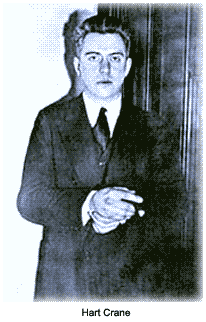 “Crane’s mind was no bigger than a pin, but it didn’t matter, he was a born poet.”
“Crane’s mind was no bigger than a pin, but it didn’t matter, he was a born poet.”
- e.e. cummings
"Hart Crane's poems are profound and deep-seeking. In them he reveals, with a new insight and unique power, the mystic undertones of beauty which move words to express vision."
- Eugene O'Neill
The early years Harold Hart Crane (no relation to Stephen Crane) was born in Garrettsville, Ohio, about halfway between Cleveland and Youngstown in the state's northeastern section. His father, Clarence, invented the LifeSaver® candy ringlet as a way to increase his summertime business when chocolate sales were lagging. Hart dropped out of high school after his parents divorced. He spent most of his time shuttling from Cleveland, where he was a sometime cub reporter and worker in his father's factory, to New York City, where he wrote copy for advertising agencies and mail-order catalogs. It was in the Big Apple that Hart discovered his homosexuality, and where he was most comfortable in a largely homophobic culture. Hart's writing was influenced early on by T.S. Eliot (The Waste Land). He identified with Eliot's style, if not his pessimism. Later on, Walt Whitman and his American sensibilities inspired him. Critics sometimes aired the notion that Hart forced his Eliot-influenced words into Whitman-esque templates. Maturing verse Crane's best-known works include The Bridge (1930), a series of poems intended to be the "American epic." They were based on his experiences and observations while coming of age in the shadows of the Brooklyn Bridge. White Buildings included some of his best lyrics; and Voyages I was an incredibly sensitive and heartfelt series of love letters to his ex-lover Emil Opffer, a Danish ship's purser, his one true love. It should be noted that Crane had a brief heterosexual affair with the ex-wife of his friend, Malcom Cowley, during his stay in Mexico in 1931-32, on a Guggenheim fellowship. That entry on the ledger's bright side inspired his last great poem, The Broken Tower. ² Epitaph Crane was in his prime during the Roaring Twenties. He got caught up in the glitz and glamour of the era. He was an intelligent alcoholic, like many of his contemporaries, and volatile when manic depression reared its hoary head. His poetic style was upbeat, as much as life would allow, but drink and unrequited love precipitated a downward spiral with predictable results. Crane committed suicide by leaping into the Caribbean from the S.S. Orizaba in 1932.